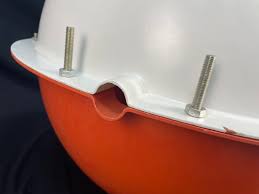In recent years, the installation of power line marker balls has become increasingly common. Often seen as a bright splash of color on the skyline, these spherical devices perform several key functions to improve safety and visibility, especially for low-flying aircraft. Understanding their purpose and size specifications is essential to understanding their role in modern utility management.
The primary purpose of marker balls is to improve visibility of power lines to low-flying aircraft. In areas where power lines cross open fields, valleys, or rivers, these marker balls serve as a visual cue to alert pilots to the presence of power lines. This is critical for helicopters, agricultural aircraft, and other low-flying aircraft that may be at risk of collision.
Marker balls not only contribute to aviation safety; they also play a role in maintaining the integrity of power lines. By making the lines more visible, the risk of accidental contact between construction equipment or large vehicles traveling near power lines is reduced. This in turn helps prevent damage to the wires, thereby avoiding costly power outages and repairs.
Modern marker balls are designed to withstand harsh weather conditions. They are made of durable materials that resist UV degradation, extreme temperatures, and strong winds. This ensures they remain effective for many years, providing a reliable method of marking wires without the need for frequent replacement.

Utilities can also benefit from using marker balls during maintenance and inspections. These balls can help crews quickly locate and assess wires, especially in heavily forested or remote areas. This can speed up the maintenance process and reduce downtime.
The size of an aerial marker ball is a key factor in its effectiveness. These brightly colored balls are not one-size-fits-all; their size can vary based on a number of factors, including regulatory requirements, the environment, and specific safety needs.
The most common aerial marker ball sizes range from 20 inches (50 cm) to 36 inches (91 cm) in diameter. The size selected depends on visibility requirements and the distances spanned by the power lines. Larger balls are often used in areas where risk factors are higher or greater visibility is needed, such as near airports or over open landscapes.
36 inches in diameter. This ensures that the marker can be easily seen by pilots at a great distance, reducing the risk of collision.
The environment plays a major role in determining the appropriate size for a marker ball. In areas with frequent fog, heavy rain, or snow, it is best to use larger balls to ensure they remain visible in adverse weather conditions. Additionally, in these areas, marker balls can be spaced closer together to further improve visibility.
Our other Fiberglass Warning Markers products are on hot sale.
Marker balls are made from durable, lightweight materials such as UV-resistant plastic or fiberglass. Size and materials must strike a balance between durability and ease of installation. Larger marker balls are designed to be lightweight to prevent additional stress on the wires while maintaining sufficient strength to withstand environmental stresses.
The size of the marker ball can also affect the installation process. Larger balls may require specialized equipment and techniques to safely and securely mount on the wires. Maintenance considerations include ensuring the ball remains in place and is free of damage, which could affect its visibility and effectiveness.
Next: None
Add.: Xiao Zhang industrial area, Zaoqiang County, Hengshui city, Hebei province, China.
Copyright © 2018 Miyafrp, all rights reserved. |Sitemap |